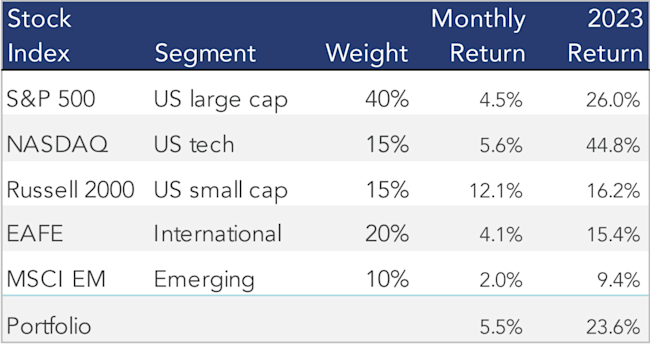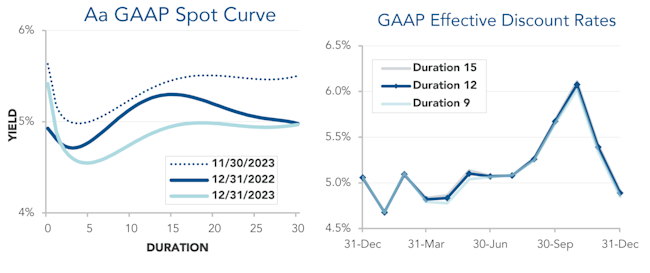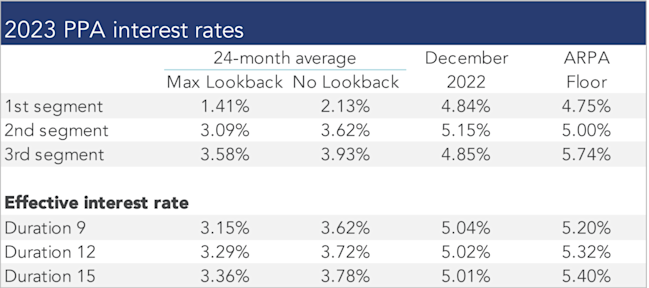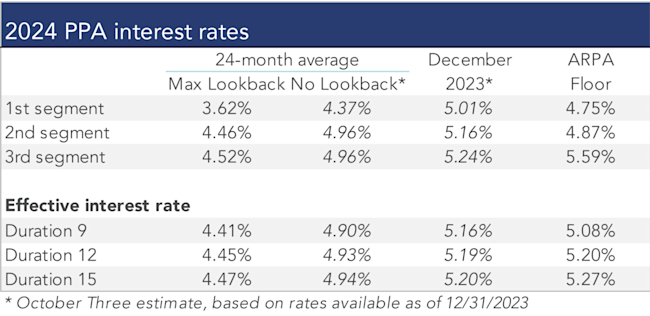Pension Finance Update December 2023
Pension finances were mixed again in December, as lower interest rates pushed up liabilities while higher stock markets increased asset values. Our model plans[1] diverged modestly, with Plan A losing 2% last month but ending 2023 up 7%, while the more conservative Plan B was flat in December, ending the year up almost 2%:
[1] Plan A is a traditional plan (duration 12 at 5.5%) with a 60/40 asset allocation, while Plan B is a largely retired plan (duration 9 at 5.5%) with a 20/80 allocation with a greater emphasis on corporate and long-duration bonds. We assume overhead expenses of 1% of plan assets per year, and we assume the plans are 100% funded at the beginning of the year and ignore benefit accruals, contributions, and benefit payments in order to isolate the financial performance of plan assets versus liabilities.

Assets
Stocks rose again in December, with all major indexes ending 2023 above or near double-digit gains. A diversified stock portfolio added more than 5% last month, ending 2023 up more than 23%:

Interest rates tumbled another 0.5% in December (producing a 1% total drop in the past two months) while credit spreads remain near record lows. As a result, bonds gained 4%-7% last month. For the year, a diversified bond portfolio earned between 3% and 7%, with corporate bonds performing best.
Overall, both plans we track gained ground last month: Plan A added 5% during December, ending 2023 with a return of 14%, while Plan B gained more than 4% last month, ending 2023 with a return above 8%.
Liabilities
Pension liabilities (for funding, accounting, and de-risking purposes) are driven by market interest rates. The first graph below compares our Aa GAAP spot yield curve at December 31, 2022 and December 31, 2023, and it also shows the sharp drop in rates last month. The second graph below shows our estimate of movements in effective GAAP discount rates for pension obligations of various duration so far this year:

Corporate bond yields fell 0.5% during December. As a result, pension liabilities jumped 4%-7%, ending the year up 5%-7%.
Summary
2023 represents another strong year for pension finance, building on improvement in prior years and improving pension funded status to the best condition this century. The graphs below illustrate the path of assets and liabilities for our two model plans during 2023:

Looking Ahead
Pension funding relief was signed into law during March of 2021, and additional relief was provided by November 2021 legislation. The new laws substantially relaxed funding requirements over the next several years, but, the increase in interest rates over the past three years means that 2024 funding targets will be comparable to market liabilities.
Discount rates fell across the board last month, while a flat yield curve continues to compress rates for plans of different durations. We expect most pension sponsors will use effective discount rates in the 4.8%-5.1% range to measure pension liabilities right now.
The table below summarizes rates that plan sponsors are required to use for IRS funding purposes for 2023, along with estimates for 2024. Pre-relief, both 24-month averages and December ‘spot’ rates, which are still required for some calculations, such as PBGC premiums, are also included.


